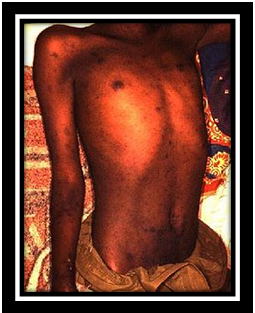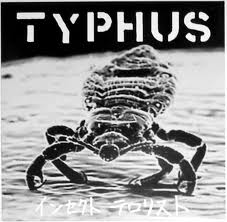Typhus is any of several similar diseases caused by Rickettsia bacteria. The name comes from the Greek typhos meaning smoky or hazy, describing the state of mind of those affected with typhus. The causative organism Rickettsia is an obligate parasite that cannot survive for long outside living cells.Typhus should not be confused with typhoid fever, as the diseases are unrelated.
Typhus:
| Disease | Typhus |
| Pathogen | Rickettsia, Rickettsia prowazekii |
| Vectors | Louse, Pediculus humanus |
| Reservoir | Humans |
| Distribution | Africa, South America, scattered elsewhere |
| Mortality | nearly 100% in epidemic conditions |
| Other Names | Brill-Zinsser disease, classical typhus, European typhus, tabardillo, war fever, jail fever |

Typhus is any of several similar diseases caused by Rickettsia bacteria. The name comes from the Greek typhos (τῦφος) meaning smoky or hazy, describing the state of mind of those affected with typhus. The causative organism Rickettsia is an obligate parasite bacterium that cannot survive for long outside living cells.

Symptoms
Epidemic typhus
- Chills
- Bad cough
- Delirium
- High fever (40 °C or 104 °F)
- Joint pain
- Low blood pressure
- Rashes
- Photophobia (sensitivity to light)
- Severe headaches
- Severe muscle pain
- Stupor
- Backache
Murine typhus
- Abdominal pain
- Backache
- Dull red rash that begins on the middle of the body and spreads
- Extremely high fever (105 to 106 °F or 41 °C)
- Hacking, dry cough
- Headaches
- Joint pain
- Nausea
- Vomiting
Prevention
The best and suggested way to prevent getting Typhus is the typhus vaccine.
Treatment
Without treatment, the disease can be fatal. Prompt treatment with antibiotics cures most patients.
- Azithromycin (one drug therapy)
- Doxycycline
- Tetracycline
- Chloramphenicol (less common)
References
- ^ “Typhus” at Dorland’s Medical Dictionary
- ^ Cotran, Ramzi S.; Kumar, Vinay; Fausto, Nelson; Nelso Fausto; Robbins, Stanley L.; Abbas, Abul K. (2005). Robbins and Cotran pathologic basis of disease. St. Louis, Mo: Elsevier Saunders. pp. 396. ISBN 0-7216-0187-1.
- ^ Ticks Factsheet NSW Department of Health
- ^ Spotted Fevers Department of Medical Entomology, University of Sydney
- ^ Ralph D. Smith, Comment, Criminal Law — Arrest — The Right to Resist Unlawful Arrest, 7 NAT. RESOURCES J. 119, 122 n.16 (1967) (hereinafter Comment) (citing John Howard, The State of Prisons 6–7 (1929)) (Howard’s observations are from 1773 to 1775). Copied from State v. Valentine May 1997 132 Wn.2d 1, 935 P.2d 1294
















